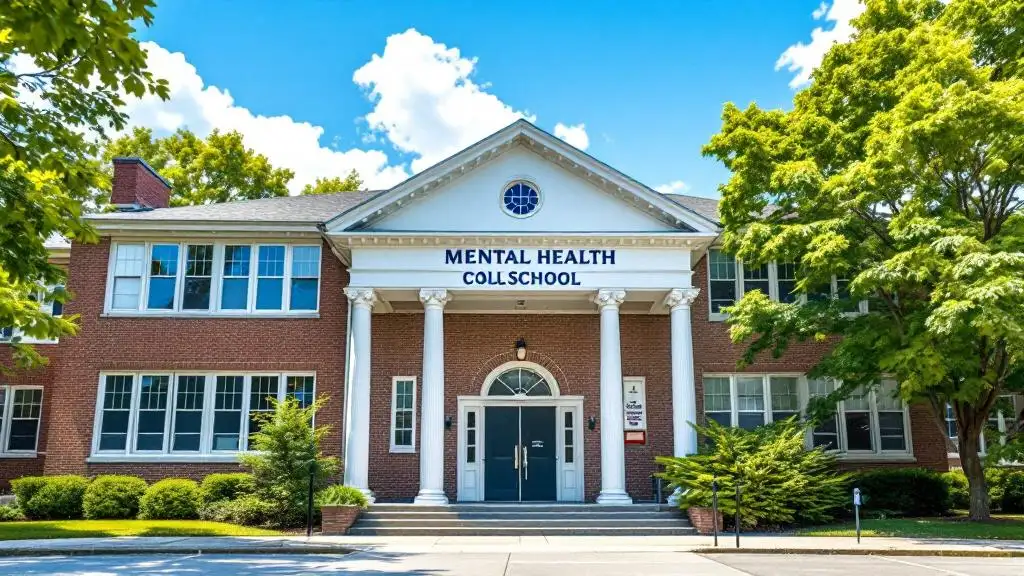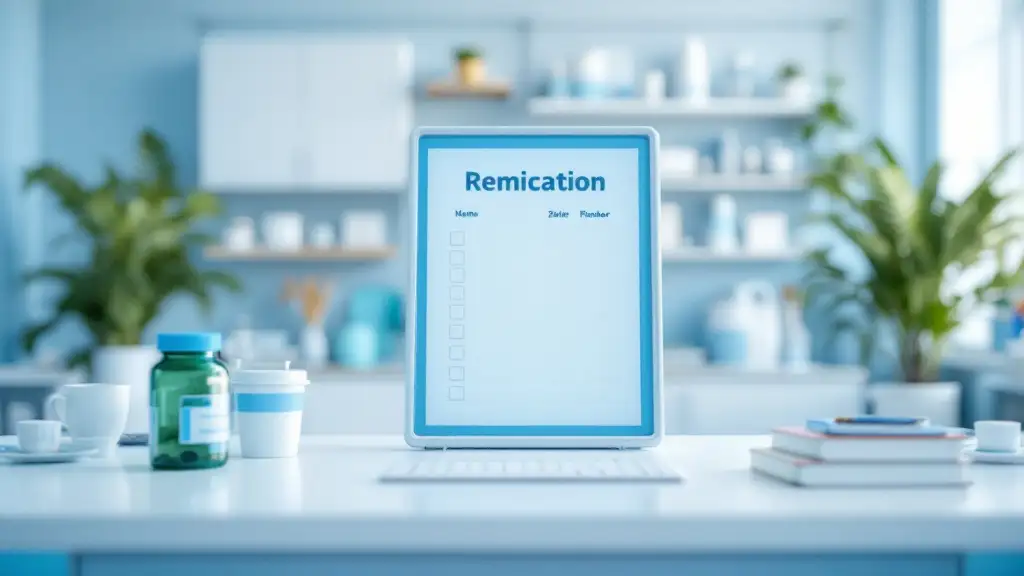The Critical Need for Optimal Medication Management in Older Adults
As the population ages, managing medications safely becomes increasingly vital to prevent adverse effects, hospitalizations, and diminished quality of life. Polypharmacy, or the use of multiple medications, poses significant health risks for older adults, necessitating robust strategies, tools, and collaborative practices to ensure safe prescribing and deprescribing practices.
Understanding Polypharmacy in Older Adults

What is polypharmacy?
Polypharmacy refers to the use of five or more medications at the same time. While sometimes necessary for managing multiple chronic conditions, it often involves both prescription drugs and over-the-counter (OTC) medicines. This combination can lead to complex medication regimens that are difficult to manage and prone to errors.
How prevalent is polypharmacy among seniors?
Polypharmacy is a common issue in elderly populations. Studies indicate that approximately 36% of adults aged 62 to 85 were affected, with the percentage increasing over time. Older adults frequently have multiple health conditions such as hypertension, diabetes, and arthritis, all requiring medication. This rising trend emphasizes the importance of regular medication review and management.
What are the health risks associated with polypharmacy?
Older adults face significant risks when on multiple medications. These include adverse drug reactions, which can cause symptoms like dizziness, cognitive impairment, and falls. Drug-drug interactions may lead to dangerous effects such as bleeding or hyperkalemia.
Moreover, polypharmacy increases the likelihood of hospitalizations due to medication-related complications. It also complicates adherence, leading to missed doses or accidental overdose. Cognitive decline and increased mortality are associated with the use of potentially inappropriate medications, particularly when combined with age-related changes in drug metabolism.
Why are older adults particularly susceptible?
The vulnerability of older adults to polypharmacy stems from multiple factors. Many have several chronic diseases requiring various drugs, often prescribed by different healthcare providers. Age-related physiological changes, such as reduced renal and hepatic function, make drug clearance less efficient, increasing toxicity risks.
Fragmented healthcare systems and inadequate communication among providers can result in unnecessary or duplicate medications. Additionally, patients and caregivers may lack awareness of medication risks or become resistant to deprescribing, further compounding the problem.
By understanding these factors, healthcare providers can better identify problematic polypharmacy and implement strategies for safer medication use. Regular assessments, patient-centered reviews, and the use of tools like the Beers Criteria and STOPP/START guidelines can help mitigate these risks and improve the quality of life for older adults.
The Role of Systematic Medication Reviews
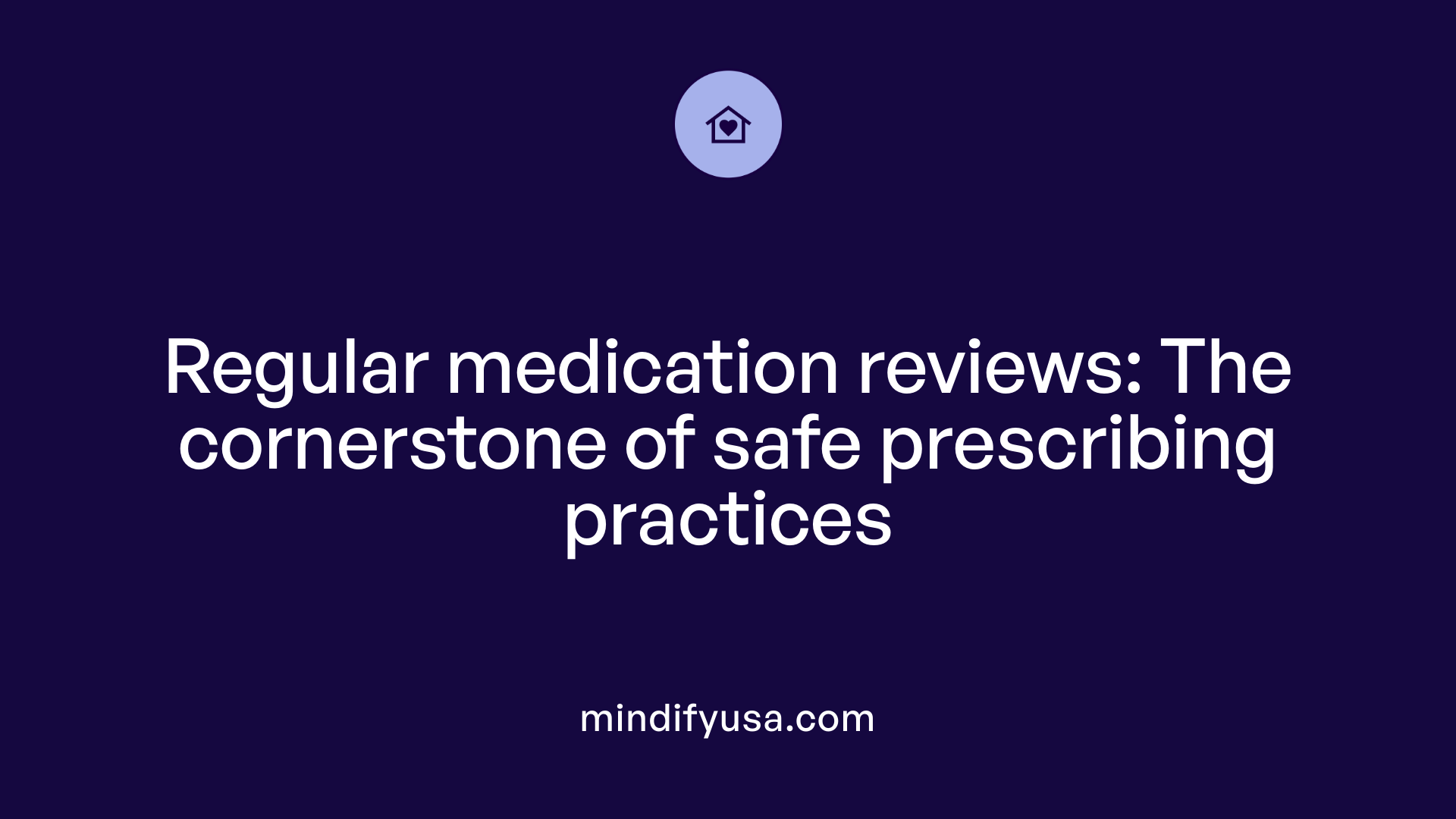
Purpose of medication reviews
Regular medication reviews are essential in managing polypharmacy among older adults. These reviews aim to evaluate the necessity, effectiveness, and safety of each medication in a patient's regimen. They help identify inappropriate, unnecessary, or potentially harmful drugs that might be contributing to adverse effects or drug interactions. Medication reviews serve to optimize therapy, reduce medication burden, and align treatments with the patient's health goals and preferences.
Frequency and timing
Medication reviews should be conducted regularly, ideally during each healthcare visit, especially during annual health assessments or when there are changes in health status. Critical moments such as hospital admissions, transfers of care, or when starting or stopping medications trigger the need for comprehensive reassessment. The goal is to ensure that the medication list remains appropriate and tailored to the patient's current needs, minimizing risks associated with polypharmacy.
Impact on reducing inappropriate medications
Systematic medication reviews significantly contribute to decreasing inappropriate drug use. By employing tools like the Beers Criteria, STOPP/START guidelines, or NO TEARS, healthcare providers can quickly identify medications that are potentially unsuitable for older adults. These reviews facilitate deprescribing—systematic discontinuation of drugs that are no longer necessary or pose risks—leading to improved safety, reduced adverse drug events, and better health outcomes.
What are effective strategies for reducing polypharmacy in older adults?
To effectively minimize polypharmacy, healthcare providers should adopt a comprehensive, person-centered approach. This includes regular medication assessments involving the patient, caregivers, and multidisciplinary teams such as pharmacists, physicians, and nurses. Leveraging screening tools like the Beers Criteria and STOPP/START guides ensures evidence-based identification of unnecessary or harmful medications.
Shared decision-making plays a pivotal role by incorporating patient preferences and treatment priorities into the deprescribing process. Education about the purpose of each medication and potential side effects enhances adherence and empowers older adults to participate actively in their care.
Coordination among healthcare professionals ensures continuity of care and systematic reassessment. Pharmacists, in particular, are crucial for conducting detailed medication reviews, detecting drug interactions, and providing patient counseling. Implementing these strategies collectively helps reduce medication burden, the risk of adverse effects, and healthcare costs.
What are the key steps in managing polypharmacy among older adults?
Effective management involves a structured, stepwise process, such as the 7-step medication review. This approach begins with understanding what matters most to the patient—whether improving function, reducing side effects, or maintaining independence. Next, it identifies essential medications and reviews for any unnecessary or duplicate therapies.
Healthcare providers then assess whether treatment goals are being met and evaluate the safety profile of each drug, paying special attention to high-risk medications like benzodiazepines, opioids, or anticholinergics. Sharing decisions with the patient about continuing, adjusting, or stopping medications is vital.
Further, clinicians should consider non-pharmacological alternatives where appropriate and plan regular follow-ups to monitor the effects of any adjustments. This process ensures that medication regimens are safe, effective, and aligned with individual priorities—ultimately supporting a better quality of life for older adults.
Utilizing Guidelines and Tools for Safe Prescribing
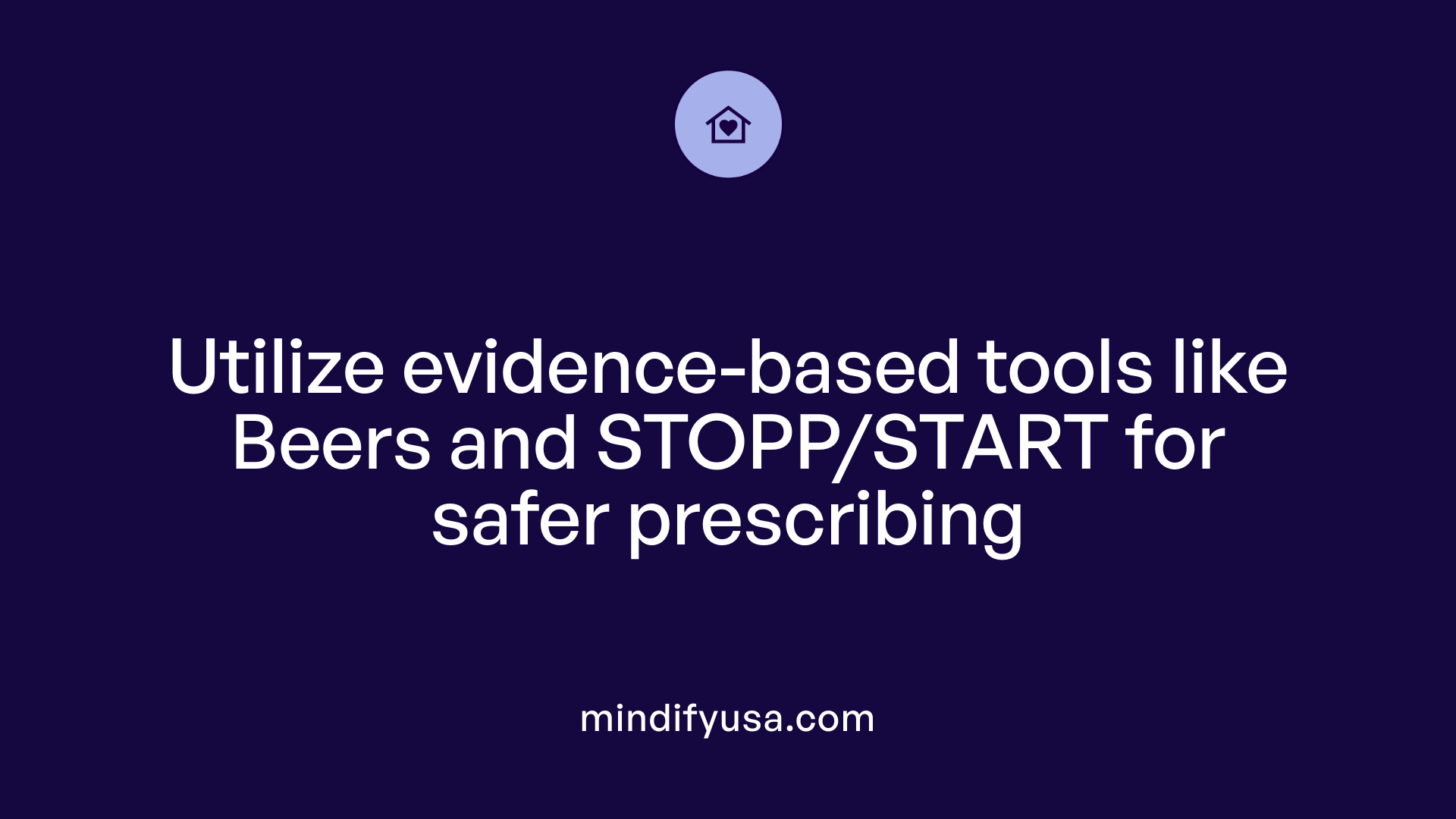
What are the tools and guidelines available to support safe medication management?
Healthcare providers have access to various evidence-based tools and guidelines that assist in managing medications safely, particularly in older adults. The Beers Criteria is widely used to identify medications that are potentially inappropriate for seniors, emphasizing drugs that may cause more harm than benefit.
The STOPP (Screening Tool of Older Persons' Prescriptions) and START (Screening Tool to Alert to Right Treatment) criteria are practical guidelines that help detect drug interactions, duplicate therapies, and unnecessary prescriptions. These tools promote optimal prescribing and deprescribing by providing specific recommendations tailored to geriatric patients.
Additionally, the NO TEARS tool offers a streamlined approach to medication review. It covers essential aspects such as indications for each drug, patient understanding, recent clinical tests, adverse events, and possibilities for medication simplification. This facilitates comprehensive medication reconciliation within brief consultation periods, improving efficiency and safety.
How do these tools influence deprescribing decisions?
These guidelines and tools play a crucial role in shaping deprescribing strategies by highlighting potentially inappropriate or harmful medications. They help clinicians prioritize which drugs should be discontinued or adjusted, especially when risks outweigh benefits.
By systematically applying these tools, healthcare providers can develop structured deprescribing plans that align with patient-specific needs and preferences. This approach reduces the likelihood of adverse drug events, decreases polypharmacy, and enhances overall medication safety, leading to better health outcomes for older adults.
Deprescribing — The Core of Managing Polypharmacy
What is deprescribing and how does it contribute to medication safety?
Deprescribing is the systematic process of discontinuing or reducing medications that are unnecessary, ineffective, or potentially harmful. It aims to lessen the medication burden on older adults, thereby decreasing the risk of adverse drug reactions, drug-drug interactions, falls, cognitive decline, and hospitalizations. Proper deprescribing enhances the overall safety and quality of life by aligning medication regimens with patients' current health status and goals.
In older populations, especially those with multiple chronic conditions, inappropriate polypharmacy—using five or more medications—can result in increased health risks. Deprescribing helps mitigate this by carefully reviewing each medication's necessity and benefits. When implemented correctly, it ensures the medications that remain truly support the patient’s health objectives and are free from unnecessary or harmful drugs.
How can deprescribing be effectively implemented?
Effective deprescribing requires a structured approach that emphasizes careful medication review, patient and caregiver involvement, and collaboration among healthcare professionals. First, clinicians should assess each medication's indication, effectiveness, and potential risks. Using tools like the Beers Criteria or STOPP/START guidelines can aid in identifying potentially inappropriate medications.
Shared decision-making plays a vital role; involving patients and caregivers in discussions about the rationale for stopping or reducing medications promotes acceptance and adherence. Developing clear, individualized plans for tapering medications and monitoring during and after the deprescribing process is essential.
Interprofessional collaboration, particularly involving physicians, pharmacists, and other care team members, enhances safety. Regular follow-ups allow for adjustments based on the patient's response and any emerging health issues. Implementing guidelines and protocols tailored to individual needs helps ensure safe, successful deprescribing practices.
Additional considerations
In complex cases, especially in patients with dementia or limited life expectancy, deprescribing becomes more straightforward, often aligning with palliative goals. Conversely, in long-term treatment contexts, it requires careful balancing of benefits versus risks.
Ensuring continuous communication, education, and monitoring is crucial for successful deprescribing. Tools such as the NO TEARS or Hyperpharmacotherapy Assessment tools facilitate efficient medication reviews, especially within busy clinical settings.
To promote widespread adoption, systemic reforms like medication reconciliation at care transitions and policy incentives for deprescribing can create an environment conducive to safer medication management in older adults.
The Role of Caregivers and Patients in Safeguarding Medication Use
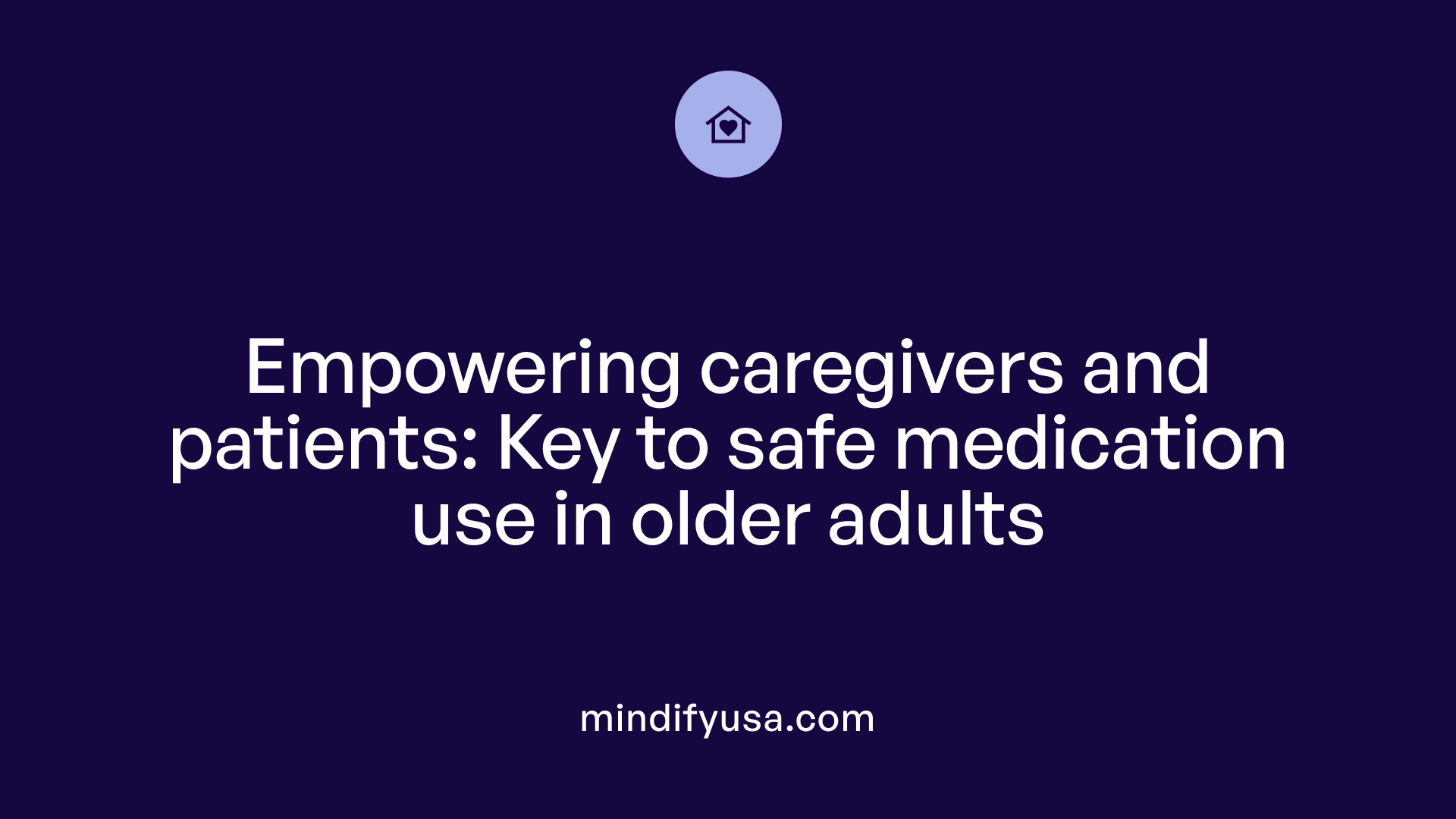
How can caregivers contribute to reducing polypharmacy risks?
Caregivers play a vital role in managing medications for older adults, especially those with multiple health conditions. They can help by maintaining an accurate and up-to-date medication list that includes details on how and when medications should be taken. This practice supports effective medication reconciliation during healthcare visits and helps prevent duplication or inappropriate prescribing.
Additionally, caregivers can ensure medication adherence by organizing doses, reminding patients of schedules, and monitoring for side effects or adverse reactions. They are also crucial in communicating any concerns or changes observed to healthcare providers, helping to inform decisions on deprescribing or adjusting treatments. Their active involvement promotes safer medication use, reduces risks associated with polypharmacy, and enhances overall health outcomes.
What educational strategies improve medication safety in older adults?
Educational strategies are fundamental to promoting medication safety. These include counseling patients and caregivers on the purpose of each medication, potential side effects, and correct administration techniques. Clear, simple language and visual aids can improve understanding, particularly for those with cognitive impairments.
Shared decision-making is also emphasized, where patients and caregivers are actively involved in discussions about treatment choices. Providing written instructions, creating easy-to-follow medication schedules, and encouraging open communication help ensure medications are used correctly. Regular education and reinforcement during clinical visits empower patients and caregivers to report problems promptly, further reducing adverse drug events and supporting optimal medication management.
Tools and Technologies Supporting Safe Medication Practices
What technological tools assist in safe medication management for older adults?
Modern healthcare relies heavily on advanced technology to ensure medication safety among older adults, who are particularly vulnerable to medication-related problems. Electronic Health Records (EHRs) serve as comprehensive digital repositories of patient information, allowing clinicians to access up-to-date medication lists, medical histories, and lab results. This visibility is crucial for accurate medication reconciliation, preventing duplicate therapies, and identifying potential drug interactions.
Clinical Decision Support Systems (CDSS) amplify the capabilities of EHRs by providing real-time alerts and evidence-based recommendations during prescribing or reviewing medications. For example, CDSS can flag drugs that are potentially inappropriate according to guidelines like the Beers Criteria or STOPP/START, and suggest safer alternatives.
Telemedicine platforms and artificial intelligence (AI) analytics further support medication management by enabling remote monitoring and predictive modeling. Telehealth facilitates ongoing patient follow-up, medication adherence assessments, and side effect monitoring without the need for frequent in-person visits. AI algorithms analyze large datasets to predict adverse drug reactions, identify high-risk patients, and optimize medication regimens tailored to individual needs.
These tools foster collaboration among healthcare providers, including physicians, pharmacists, and nurses, ensuring comprehensive and continuous care. They help streamline complex medication reviews, improve communication, and support timely interventions, ultimately reducing the risks associated with polypharmacy in older populations.
What are the challenges and opportunities of implementing such tools?
Despite their benefits, integrating these technology solutions into everyday practice faces several challenges. Limited resources or funding can restrict the adoption of sophisticated systems, especially in smaller practices or under-resourced settings.
Training healthcare providers on new systems is essential but can be time-consuming. Data privacy concerns also pose barriers, requiring robust security measures to protect sensitive patient information.
Interoperability remains a significant hurdle, as many systems cannot communicate seamlessly across different healthcare networks, leading to fragmented information.
On the flip side, these challenges present opportunities for innovation. Leveraging technology can provide personalized care through data-driven insights, enable real-time alerts to prevent harmful drug interactions, and facilitate population health management by identifying high-risk groups.
Future developments might include more user-friendly interfaces, broader AI applications, and enhanced interoperability standards. As these tools become more sophisticated and integrated, they promise to significantly improve medication safety and reduce polypharmacy risks among vulnerable older adults.
Addressing Systemic Barriers to Optimal Medication Management
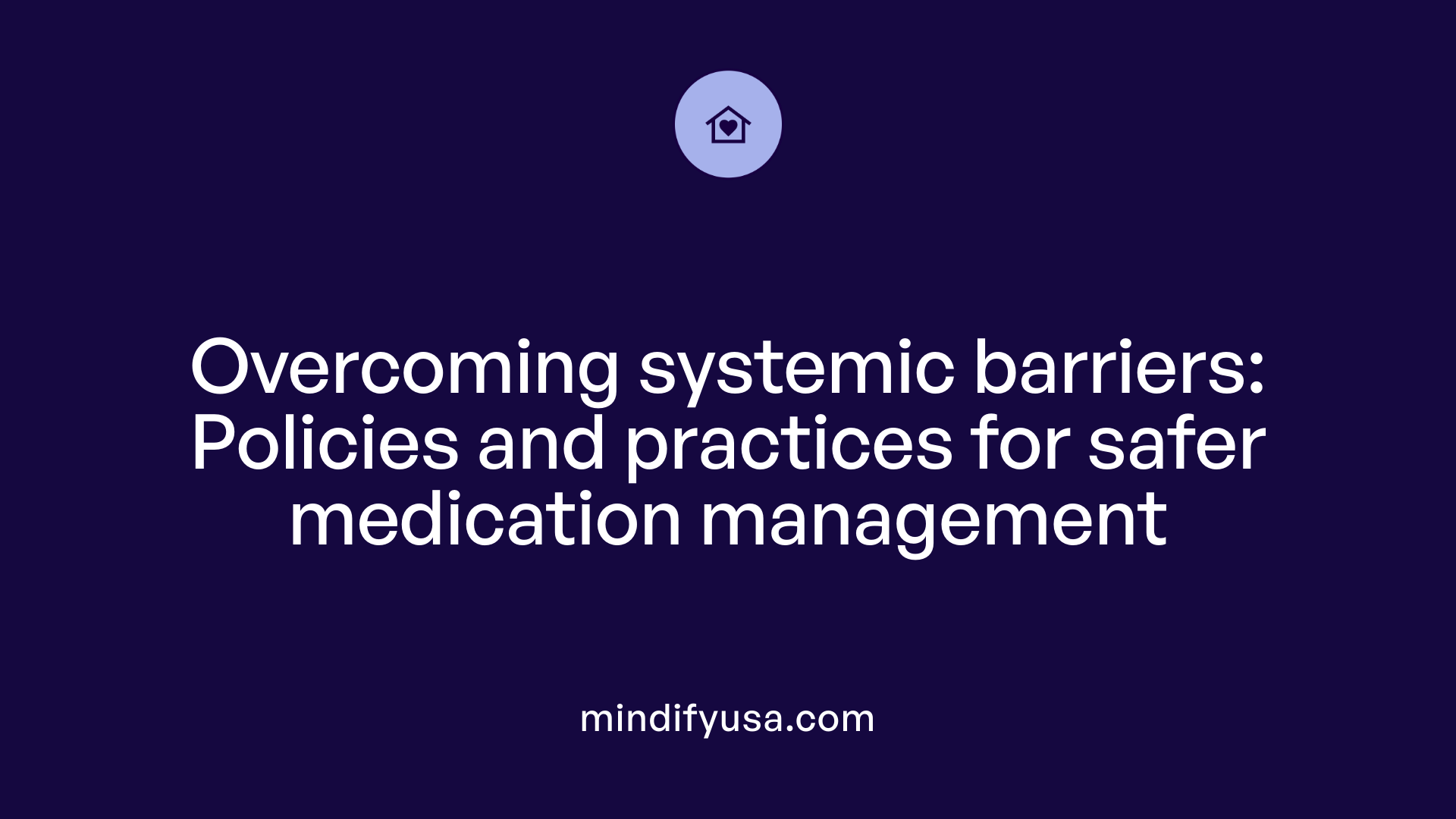
What systemic reforms support safer medication practices?
System reforms play a crucial role in fostering safer medication management, especially among vulnerable populations like older adults. Policy incentives for deprescribing encourage healthcare providers to regularly review and reduce unnecessary medications, thereby minimizing polypharmacy risks. Medication reconciliation programs streamline accurate medication lists across different healthcare settings, reducing errors and duplications.
Quality metrics and systemic guidelines promote a culture of safety by measuring prescription appropriateness and adherence to best practices. These initiatives often include mandatory medication reviews and documentation standards that support continuous improvement.
Furthermore, establishing integrated care networks facilitates better communication among multidisciplinary teams, ensuring that medication decisions are coordinated effectively across primary care, specialists, pharmacists, and caregivers. Such reforms create an environment conducive to proactive, patient-centered medication management.
How can healthcare systems improve medication management for seniors?
Enhancing medication management for seniors requires a combination of structured protocols and collaborative approaches. Standardized procedures, such as routine use of screening tools like the Beers Criteria and STOPP/START guidelines, help identify potentially inappropriate medications.
Education and training for healthcare providers ensure they are equipped with current best practices in deprescribing and comprehensive medication review. Interprofessional collaboration involving physicians, pharmacists, nurses, and geriatric specialists ensures comprehensive assessment and shared decision-making.
Integrating clinical decision support tools into electronic health records can alert prescribers about drug interactions and high-risk medications in real-time. Promoting patient engagement through education on medication purpose, side effects, and withdrawal plans enhances adherence and safety.
Overall, a system-wide commitment to these strategies can significantly reduce polypharmacy, prevent adverse drug events, and improve health outcomes for older adults.
Future Directions and Innovations in Medication Safety
What are future directions in managing polypharmacy risks?
The landscape of medication safety for older adults is evolving rapidly, with promising developments on the horizon. Future strategies are leaning toward personalized medicine approaches that consider individual genetic profiles, enabling tailored medication regimens that maximize benefits and minimize harms.
Moreover, the integration of advanced predictive analytics aims to identify patients at high risk of adverse drug events more accurately. Using electronic health records and machine learning algorithms, healthcare providers can proactively address potential issues before they lead to complications.
Finally, a greater emphasis is being placed on patient-centered care. This approach involves engaging patients actively in decision-making processes, aligning treatments with their preferences, goals, and quality of life considerations. Deprescribing protocols are expected to become more individualized, ensuring therapies are truly necessary and safe.
How can innovations improve medication safety?
Technological advancements are central to improving medication safety. Artificial intelligence-driven clinical decision support systems (CDSS) can analyze vast amounts of data to alert clinicians about potential drug interactions, inappropriate prescriptions, and opportunities for deprescribing.
Telehealth platforms facilitate regular medication reviews, especially in remote or underserved areas, allowing for continuous monitoring and timely adjustments. These tools help bridge gaps in care, ensuring older adults receive ongoing support.
Additionally, the integration of comprehensive health data from various sources empowers both clinicians and patients. Patients can access their medication lists, understand side effects, and participate actively in care decisions, fostering trust and adherence.
Together, these innovations will support more precise, safe, and patient-centered medication management, reducing the risks associated with polypharmacy and enhancing overall outcomes for aging populations.
| Future Focus Area | Key Innovation | Impact |
|---|---|---|
| Personalized medicine | Pharmacogenetics | Tailored medications and doses, reducing adverse effects |
| Predictive analytics | Machine learning models | Early risk detection and intervention |
| Patient engagement | Digital health tools and shared decision-making | Improved adherence, satisfaction, and safety |
Exploring these avenues, healthcare systems are poised to significantly improve the safety and effectiveness of medication use among older adults, ultimately enhancing their quality of life.
Summary and Recommendations for Best Practice
Core principles
Effective management of polypharmacy in older adults revolves around fundamental principles such as thorough medication reviews, deprescribing unnecessary or harmful drugs, and using evidence-based tools like the Beers Criteria and STOPP/START guidelines. Regular medication review is crucial, especially during health maintenance visits, to ensure each medication's necessity, effectiveness, and safety. Reorganizing medication lists by condition, rather than alphabetically, can help identify consolidation opportunities or the need for deprescribing. Emphasizing personalized care, considering patient goals and preferences, enhances safety and adherence.
Multidisciplinary approach
A team-based strategy is vital for optimal medication management. Pharmacists play a key role in medication reconciliation, interaction assessment, and patient education. Geriatricians, nurses, and primary care providers should collaborate to review medication regimens, address polypharmacy risks, and implement deprescribing protocols systematically. Tools like NO TEARS assist in quick medication reconciliation, fostering efficient workflows. Interprofessional collaboration ensures comprehensive evaluation, minimizes adverse drug events, and promotes safe practices.
Patient and provider engagement
Involving older adults and their caregivers is essential for successful medication optimization. Clear communication regarding treatment goals, medication reasons, and potential side effects encourages shared decision-making. Educating patients about nonpharmacologic alternatives and the benefits of deprescribing can reduce resistance. Developing follow-up plans and discussing medication adjustments openly fosters trust. Regular medication reconciliation and addressing concerns about withdrawal or rebound effects help sustain safety and adherence.
What are the key takeaways for managing polypharmacy in older adults?
Key takeaways include conducting regular, comprehensive medication reviews; utilizing evidence-based tools and guidelines; engaging patients and caregivers in decision-making; deprescribing unnecessary medications carefully; and fostering a multidisciplinary approach for safe, effective medication management.
What future strategies are needed to improve outcomes?
Future strategies should incorporate technological advancements, systemic policy reforms, personalized medicine, and ongoing education to further reduce inappropriate polypharmacy and enhance older adults' health and quality of life.
Towards Safer and More Effective Medication Use in Older Adults
In summary, optimizing medication management in older adults requires a structured, multidisciplinary approach leveraging evidence-based tools, promoting deprescribing, empowering patients and caregivers, and embracing technological innovations. Continued systemic reforms and ongoing education are crucial to address the complexities of polypharmacy, ultimately improving safety, reducing adverse events, and enhancing the overall quality of life for seniors.
References
- Strategies to Reduce Polypharmacy in Older Adults - StatPearls - NCBI
- The dangers of polypharmacy and the case for deprescribing in ...
- Polypharmacy: Evaluating Risks and Deprescribing - AAFP
- Managing polypharmacy through medication review tools – pros ...
- [PDF] Medication Safety in Polypharmacy
- Five Tips for Addressing Polypharmacy in Older Adults
- Did You Know? Medication Management to Address Polypharmacy












